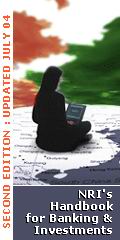|


|
Global financial markets hit by renewed credit woes
10 December 2007: Further deterioration in the US housing market and concerns about associated economic and financial risks continued to take centre stage, according to The BIS Quarterly Review. Prices for risky assets had recovered into October, as earlier worries about systemic risk had eased, not least because of determined central bank action in the money markets. However, uncertainties about subprime and other credit market exposures remained, adding to more general concerns that US housing market woes would deepen and eventually contribute to broader economic weakness. With market participants refocusing on these risks and liquidity conditions in money markets remaining tense, sentiment worsened once again from mid-October.
Against this background, and with oil prices surging to new highs, share prices fell sharply in major equity markets. The financial sector was particularly badly hit, following a string of multibillion dollar credit-related writedowns by banks. Adding to this, third quarter year-on-year corporate earnings growth was negative in the United States for the first time in several years.
In this environment, government bond yields in major industrialised economies fell as investors again fled to safety, but also as the result of an anticipated weakening of economic activity. Heightened expectations of monetary policy easing, in particular in the United States, added to the decline in yields. Such expectations, in combination with the sharp rise in oil prices, may have contributed to rising break-even inflation rates in a number of markets.
While being drawn into more general market weakness later in the period, emerging market assets were supported by perceptions that downside risks to growth in many emerging markets would be more limited than for the major industrialised economies. Emerging market equities, in particular, outperformed their counterparts in the mature markets on assumptions of continued robust earnings growth.
In the international debt securities market, issuance retreated sharply during the turmoil in financial markets in the third quarter of 2007. Borrowing in euro-denominated bonds and notes was hit hardest, while the dollar and sterling segments slowed as well, although less appreciably. The decline in euro borrowing reflected weak issuance from French and German residents. The slowdown in borrowing was also evident in the emerging markets as issuance fell dramatically in emerging Asia and Europe. This may have stemmed from a retreat in risk appetite, since issuance of lower-rated bonds and notes in developed countries plummeted as well.
The turbulence in financial markets led to the busiest trading on record on the international derivatives exchanges. Activity was particularly strong in derivatives on short-term interest rates, perhaps because traders shifted some trading from the spot market or the OTC derivatives market onto exchanges. Rapid growth was also recorded in contracts on stock indices and on foreign exchange. Combined turnover in listed interest rate, currency and stock index derivatives rose by 27% to $681 trillion between July and September, after remaining stable in the previous quarter.
The results of the latest Triennial Central Bank Survey of Foreign Exchange and Derivatives Market Activity, shows that positions in the OTC market have increased at a rapid pace since the last triennial survey was undertaken in 2004. Notional amounts outstanding of such instruments totalled $516 trillion at the end of June 2007, 135% higher than the level recorded in the 2004 survey. This corresponds to an annualised compound rate of growth of 33%, which is higher than the approximately 25% average annual rate of increase since the current format of the survey was established in 1998.
In the international banking market, activity returned to a more moderate pace during the second quarter of 2007 after a surge in the first quarter. Cross-border claims expanded by $1.3 trillion to stand at $30 trillion. The main destinations were entities in the United States, the euro area and emerging markets.
Lending to private non-banks grew at 23% year-on-year. Bank credit to emerging markets hit a new record, with total claims expanding by $201 billion. Of net new claims on emerging markets ($104 billion), half were on emerging Europe, contributing to the continued rapid growth of credit in the region. The consolidated statistics show that much of the expansion overall was driven by German, French and US banks, and was accompanied by a strong rise in contingent facilities such as credit commitments and, especially, guarantees. They also show that the large flows to emerging markets have raised the emerging market share in BIS reporting banks’ portfolios to some 12%.
Asian banking systems hold stable to positive outlook ... Click here
Asian banks now occupy a stronger position
... Click here
CLICK FOR MORE RATING RELATED STORIES
CLICK FOR MORE FEATURES & STORIES
|
|



|






